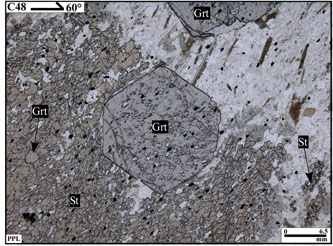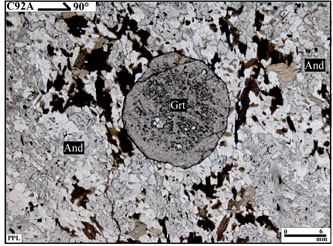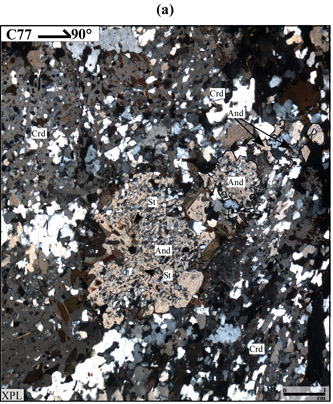Inclusions of porphyroblastic phases within others
Figure 14a, shows an example of a euhedral garnet porphyroblast included within a poikiloblastic staurolite. A few examples of garnet inclusions preserved within andalusite and cordierite were also observed (e.g. Fig. 14c, d). These relationships suggest the growth of garnet occurred before the formation of staurolite, andalusite and cordierite. Staurolite porphyroblasts in a few samples were partially and/or completely replaced by andalusite or cordierite (Fig. 15). The inclusions within the staurolite in these situations are texturally and geometrically distinct from those within andalusite and cordierite. Inclusions of staurolite and andalusite occur within cordierite porphyroblasts in a few samples (e.g. C93A and C77; Fig. 16). In C93A, staurolite inclusions are preserved within andalusite, which suggests that staurolite grew before andalusite and was latter consumed by a reaction, which produced andalusite.
Figure 14. The photomicrographs show garnet porphyroblast within younger mineral phases
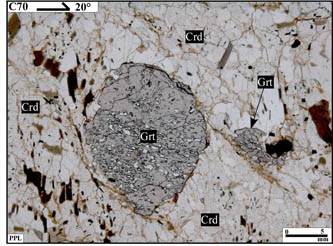
The photomicrographs illustrate an example of garnet porphyroblast enclosed within the younger (top) staurolite, (middle) andalusite and (bottom), cordierite porphyroblasts. The foliations within garnet in all these examples are texturally older than the enclosing mineral phase and matrix foliations. The strike (arrow), way up (single barb) and sample number of each vertical thin section is shown in the upper left corner. PPL = plane polarized light. St = staurolite, And =andalusite and Crd = cordierite.
Figure 15. The photomicrographs show staurolite grains replaced by andalusite and mica

(a) The photomicrograph shows a staurolite porphyroblast that has been replaced by andalusite. (b) Enlarged view of a staurolite inclusion within the andalusite porphyroblast. (c) A staurolite porphyroblast enclosed and slightly replaced by cordierite. (d) Shows a staurolite porphyroblast that has been partially replaced by cordierite. Traces of staurolite can be seen within the cordierite. Coarse grained muscovite have subsequently replaced the cordierite or were produced during the same process which replaced staurolite. The strike (arrow), way up (single barb) and sample number of each vertical thin section is shown in the upper left corner. PPL = plane polarized light, XPL = cross polarized light. St = staurolite, And = andalusite, Ms=muscovite and Crd = cordierite.
Figure 16. The photomicrograph shows andalusite blast replaced by cordierite
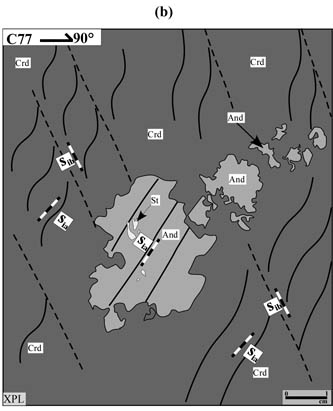
Shows an andalusite porphyroblast that has been replaced by cordierite that preserves a crenulated and a crenulation cleavage. Andalusite appears to contain an earlier formed foliation and also preserves relics of staurolite grains. The strike (arrow), way up (single barb) and sample number of each vertical thin section is shown in the upper left corner. Se = external foliation, Si =Internal foliation, XPL = cross polarized light, And = andalusite, St = Staurolite and Crd =cordierite.
These mineral relationships suggest that garnet grew before staurolite, followed by andalusite and then cordierite. Differentiating quantitatively between different generations of these mineral phases by simple microstructural relationships was not possible. However, the measurement of the FIAs contained within them suggests four generations of garnet and staurolite porphyroblasts and two each of cordierite and andalusite phases formed in this region (see below). Fibrolitic sillimanite occurs as a late phase on the boundaries of andalusite and cordierite porphyroblasts (Fig. 17).
Figure 17. The photomicrographs show late andalusite and cordierite grains

The photomicrographs illustrating some rare examples in which the (a) andalusite and(b) cordierite porphyroblast just overgrew the matrix foliation without any deflection of inclusion trails associated with deformation during their growth. ((c) and (d)), Shows an example of fibrolitic sillimanite incorporated within (c), cordierite and (d), andalusite porphyroblast. In ((e) and (f)), fibrolitic sillimanite is just overgrowing the matrix phase. Sample number with its vertical thin section orientation and strike is shown on upper right corner. Thick barbed arrow shows way up. PPL = plane polarized light; CPL = cross polarized light. Grt = garnet, St =staurolite and Bt = Biotite, And = andalusite, Crd = cordierite and Sill = sillimanite.
